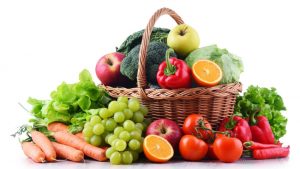Submitted by Dave Draeger, CDM, CFPP,
Director of Dietary and Dining Services

At some point in time we have all heard “eat more fruits and vegetables.” No one disputes the benefits and healthfulness of eating fruits and vegetables, yet it remains difficult for most to consume the suggested amounts. The 2015 -2020 Dietary Guidelines for Americans indicates vegetable intake is below suggested levels for all age groups.
Boosting produce intake may reduce the risk of chronic and noncommunicable diseases. Increasing fruit and vegetable intake may alter a person’s diet profile by displacing less healthy foods, which improves overall health.
Cardiovascular Disease (CVD) associated with high blood pressure and chronic inflammation may be reduced by consuming 13 to 18 ounces of produce per day. Intake of 28 ounces of produce daily had the greatest advantage in lowering risk of CVD. The DASH diet (Dietary Approach to Stop Hypertension) showed improvements in established markers for arterial health.
Observational research on diabetes shows mixed results. Two or three daily servings of vegetables and two servings of fruit may lower risk of diabetes. Replacing concentrated sweets and high carbohydrate foods with produce generally is a good choice for diabetes control.
Produce intake has shown improvements in psychological health. Benefits include increased vitality, flourishing, and motivation. Various minerals and vitamins present in produce have known effects on the mechanisms of depression.
Bone health has shown to improve with increased consumption of produce. Research and studies dating back to the 1960’s indicate healthier bones and a decrease in bone loss with a diet rich in fruits and vegetables.
Cognitive health associated with Alzheimer’s disease and dementia continues to be studied. The MIND diet (Mediterranean-DASH Intervention for Neurodegenerative Delay) has been shown to reduce age-related cognitive decline. The MIND diet singles out leafy vegetables and berries.
The Dietary Guidelines for Americans (or USDA MyPlate) are resources to use in determining produce intake. Generally speaking, intake of vegetables should be about two and a half cups per day, from all five vegetable subgroups. Dark green vegetables provide vitamin K; red/orange vegetables: vitamin A; legumes: dietary fiber; starchy vegetables: potassium; and other: a wide variety of nutrients. Fruit intake is suggested to be two cups per day. Fruits and vegetables come in a variety of forms, so what counts as a cup or ounce varies. Portion size does not always align with cup or ounce equivalents.
Increasing produce intake can be challenging for numerous reasons but upping the intake is not difficult. One easy way is to add to favorite dishes, toss in more vegetables to the stew or soup. When roasting meats, place vegetables in the oven for unique taste. Attempt to eat salad daily. Add fruits to salads for a double punch. Fresh or frozen berries to cereal. Retail outlets have a variety of prepacked fruits and vegetables for sale. Snack on dried fruit or pre-cut vegetables in place of the chips and candy. Exchange plant based proteins for animal proteins.
Are you willing to accept the challenge and reap the rewards from the power of produce? Good luck.
